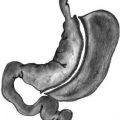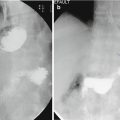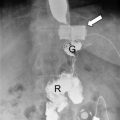© Springer International Publishing AG 2018
Andrea Laghi and Marco Rengo (eds.)Imaging in Bariatric Surgeryhttps://doi.org/10.1007/978-3-319-49299-5_33. The Role of Imaging Before and After Surgery
(1)
Department of Radiological, Oncological and Pathological Sciences, Polo Pontino,I.C.O.T. Hospital, University of Rome SAPIENZA, Latina, Italy
3.1 Before Surgery
In the preoperative phase, a multidisciplinary approach is recommended to evaluate obesity-related comorbidities.
As regards the radiological exams usually performed before bariatric surgery, they consist of chest X-ray, ultrasonography study (US) of the upper abdomen, and US of the thyroid. The US of the right upper quadrant is mainly performed to find cholelithiasis. The incidence of cholelithiasis is about 15–25% in obese patients [1], and, moreover, the risk of occurrence of cholelithiasis increases with rapid weight loss of more than 25% [2]. By detecting it before procedure, the surgeon might decide to perform cholecystectomy at the same time of bariatric surgery [3]. The US of thyroid is performed because the thyroid endocrine diseases are the most common endocrine diseases in obese patient after diabetes mellitus and, if not properly identified and treated, may represent a limit for the success rate of the bariatric surgery [4].
Actually there is no consensus on performing routine UGI radiography. Most of the surgeons considered it unnecessary. However, some studies demonstrate that it can provide important additional information influencing the operative procedure [5]. The UGI radiography with the use of oral barium contrast allows to assess patient’s anatomy abnormalities such as malrotation (because these procedures are most of the times laparoscopic and anatomic, orientation may be misunderstood), esophageal motility disorders, gastric emptying, and hiatal hernia. In particular, the detection of hiatal hernia is important because its surgical correction during bariatric surgery improves patient outcomes and decreases reoperation rate. UGI radiography is more sensitive than endoscopy to detect hiatal hernia , especially by utilizing right anterior oblique technique instead of the commonly used upright technique [6]. Some institutes perform UGI radiography also to rule out occult peptic ulcer , that is, an absolute contraindication for bariatric surgery; however, recently, for this purpose endoscopic evaluation and screening for Helicobacter pylori are often preferred [1].
3.2 After Surgery
The most commonly imaging modalities used after bariatric surgery are the upper gastrointestinal (UGI) radiography and the computer tomography (CT).
The incidence of postoperative complications (both leak and stenosis, which are the most common) is low, and it decreased with the advancement of surgical techniques. For this reason, some recent studies consider unnecessary to perform routine UGI after bariatric surgery in asymptomatic patients because the potential benefit seems low compared with the costs and recommend to reserve the exam only for patients with clinical evidence of complications evaluable with radiography (e.g., leak, obstruction, and perforation) [7–14]. However, other studies prefer to perform routine UGI to assess the surgery and to diagnose possible complications because of clinical difficulties found in some cases [15, 16]. Among these last studies, the timing of the exam is also debated. In some cases the exam is routinely performed within the first and second postoperative days in order to obtain early diagnosis and prompt treatment, in other cases in the third postoperative day because UGI has considerable number of false-negative results in the early postoperative period, especially in case of leak [17]. It is generally recommended to perform CT in case of negative result at the UGI and persistence of clinical suspicion of complications, because it has more sensitivity and specificity and it is less operator dependent than UGI radiography [18]. CT is also performed in addition to the UGI radiography in case of diagnosis of leak to confirm the finding and exclude abscess formation [17]. CT is the first choice when patient is not able to stand in the upright position; when there is clinical suspicion of abscess, small bowel obstruction , internal hernia, and intussusception ; and when other diagnoses are considered [19]. Familiarity with the surgical procedures and postoperative anatomy is essential for correct image interpretation.
3.3 Procedures
UGI radiography consists of an initial scout film of the abdomen to detect possible free extraluminal air and to facilitate the differentiation of surgical findings from contrast during fluoroscopic exam. The patient is then positioned in a semiupright position on the fluoroscopic table and swallows the oral contrast. The fluoroscope is activated by the radiologist for a few seconds prior to and then following the administration of the contrast. Images of the esophagus, stomach, and jejunum were obtained. The contrast can be water-soluble iodinated or barium contrast given orally or through the nasogastric tube; the first one is preferred in case of suspicion of leak (if patient is not allergic to iodine), the second one when there is no suspicion of leak or significant aspiration and in the preoperative period. Although small amounts of aspirated barium as well as of extraluminal barium from leakage can be well tolerated, this approach is recommended to minimize harm [20]. For this reason, after surgery, water-soluble contrast is usually used in the early postoperative period (because of increased risk of asymptomatic leak) and barium contrast in the late postoperative period. It must consider that not always leaks were seen with iodinated contrast, because it is not as dense as barium. For this reason, dual-phase exams can be done when leakage is suspected, first with iodinated contrast and then with small amounts of barium if no leak is seen with the first one [20].
The amount and the concentration of water-soluble iodinated contrast are usually 60 ml and 350 mgI/mL. The consistency (thin liquid, nectar-thick liquid, honey-thick liquid, pudding or cookie) and the volume of barium contrast are not well standardized [21].
Abdominal CT is performed with water-soluble iodinated contrast given orally or through the nasogastric tube with thin sectional acquisitions (approximately 3.0-mm section thickness) and reconstruction in axial, sagittal, and coronal planes. As the UGI radiography, the exam consists of a first scan without oral contrast and then a second scan with oral contrast to differentiate surgical findings from probable leak. The acquisition comes shortly after ingestion of oral contrast because the opacification of the stomach occurs immediately if there are no esophageal diseases and the opacification of the entire small bowel is not necessary. Since all of the common bariatric surgeries cause a reduction of gastric volume, a reduced amount of oral contrast agent (approximately 60 mL) is generally used [19]. The additional use of intravenous contrast media is recommended in case of suspicion of vascular complications and abscess. In these cases, arterial and venous phases or only venous phase is obtained. The amount of intravenous contrast media is based on patient’s weight as non-bariatric surgery patients.
Stay updated, free articles. Join our Telegram channel

Full access? Get Clinical Tree







